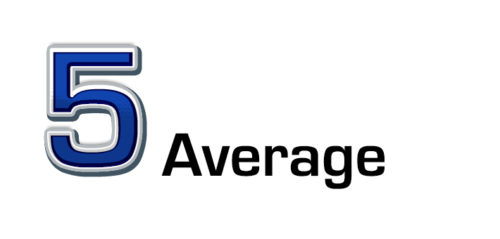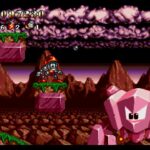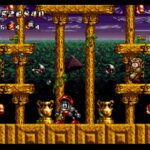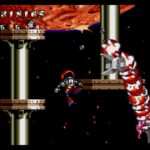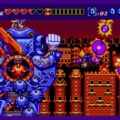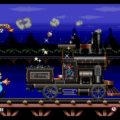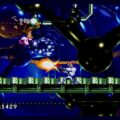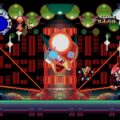Developer: Micropose Publisher: Spectrum Holobyte Release: 10/94 Genre: Platformer
As the mascot platformers raged on to the end of the 16-bit generation developers would finally “get” it. The realization that it takes more than a cute face and some floating platforms to grab the attention of gamers would lead to some cool characters like Earthworm Jim, Sparkster, and even underrated ones like Ardy Lightfoot. But some creators would still make the same mistakes of the past and doom otherwise good games. Tinhead is a game that has the look of a winner but squanders its potential with a myriad of flaws that ruin the experience.
An intergalactic goblin named Grim Sludge has stolen all the stars using his vacuum cleaner nosed spaceship, sealed them in glass spheres and scatters them across the universe. This is a catastrophe waiting to happen unless someone can do something about it. Tinhead, the Guardian of the Edge of the Universe, receives a distress signal and springs in to action to save the universe.
The plans for Tinhead were ambitious. The game was planned for the Amiga, SNES, and even Atari Jaguar at one point. While it sounds strange the mascot craze was big business back then. Unfortunately only the Sega Genesis version barely managed to release and a year after its initial plan. The SNES version was complete but developer Micropose ran out of money. But through the wonders of the internet you can buy that version too through Piko Interactive. The question is should you?
The control and their feel are the first problem with Tinhead. The best way to describe the is awkward. Tinhead can throw balls at three different heights, diagonal, forward, and overhead. To do this you switch with a button which is cumbersome. This comes in to play heavily by the second world and is frustrating. The game has a narrow field of view and allows you to look around but only while paused. Considering the number of blind leaps and such this is annoying. Worst of all though is the jumping control. Tinhead drops like a brick after a leap. His arc is already problematic as is but this exacerbates it. This is a game heavy on platforming and this problem almost single-handedly ruins it. But it gets worse.
The level design is where Tinhead fails the hardest. To be completely frank the level design is mediocre. It exhibits all of the common failings of the subpar efforts from that era. There are blind leaps of faith, suspect enemy placement, and way too many god damn spikes. The sprites are large and the viewpoint appears zoomed in so that you can only see a few feet in front of you. You can pause and pan the camera around to see if there are spikes or other hazards ahead but the game relies on this entirely too much. The entire game feels off, like platforms are a few centimeters too far or that hazards are too densely packed together. The best way to describe it is a first draft where everything was placed haphazardly with the intent to go back and fix it but that polish never came.
Tinhead suffers heavily from repetition. There are only five or six enemy types throughout the entire game and it grows old fast. But more damning is the game’s structure. Technically there are four levels in Tinhead. But each level has three sectors which each have two stages. The distinction is ssmall as the environment only changes slightly if at all between sectors. This means you are spending six stages per world, fighting the same enemies among levels and hazards that all start to blend together. As the maps become larger it gets tedious fast. This is something that the designers at Sega realized with the original Sonic the Hedgehog; three acts per zone were far too much. Reducing the number while featuring more new worlds would have been far better. They certainly have the artistic chops to create interesting worlds, the game needs variety bad.
I guess my frustration comes from the fact that you can see the bones of a decent game underneath the mountain of flaws. I dig the space theme as it was not common for platformers back then. The art is great and the line scrolling in the backgrounds makes it look like a last generation title. Having to find the star first before exiting the level gives a reason to fully explore each map. There are some cool vehicles to play around with to aid in this every so often which is cool. But whenever you start to enjoy yourself some flaw rears its head, almost as if the game is telling you to stop that. The myriad cheap deaths, repetitive stages, and sky high difficulty conspire to relegate this one to the forgotten platform graveyard sadly.
In Closing
Unfortunately Tinhead is a forgettable platformer in the mascot war. It looks great but sadly the gameplay does not match its production values. Tinhead makes far too many amateur mistakes for it to be a worthwhile endeavor. The Genesis is blessed with many great platformers, this is not one of them.
